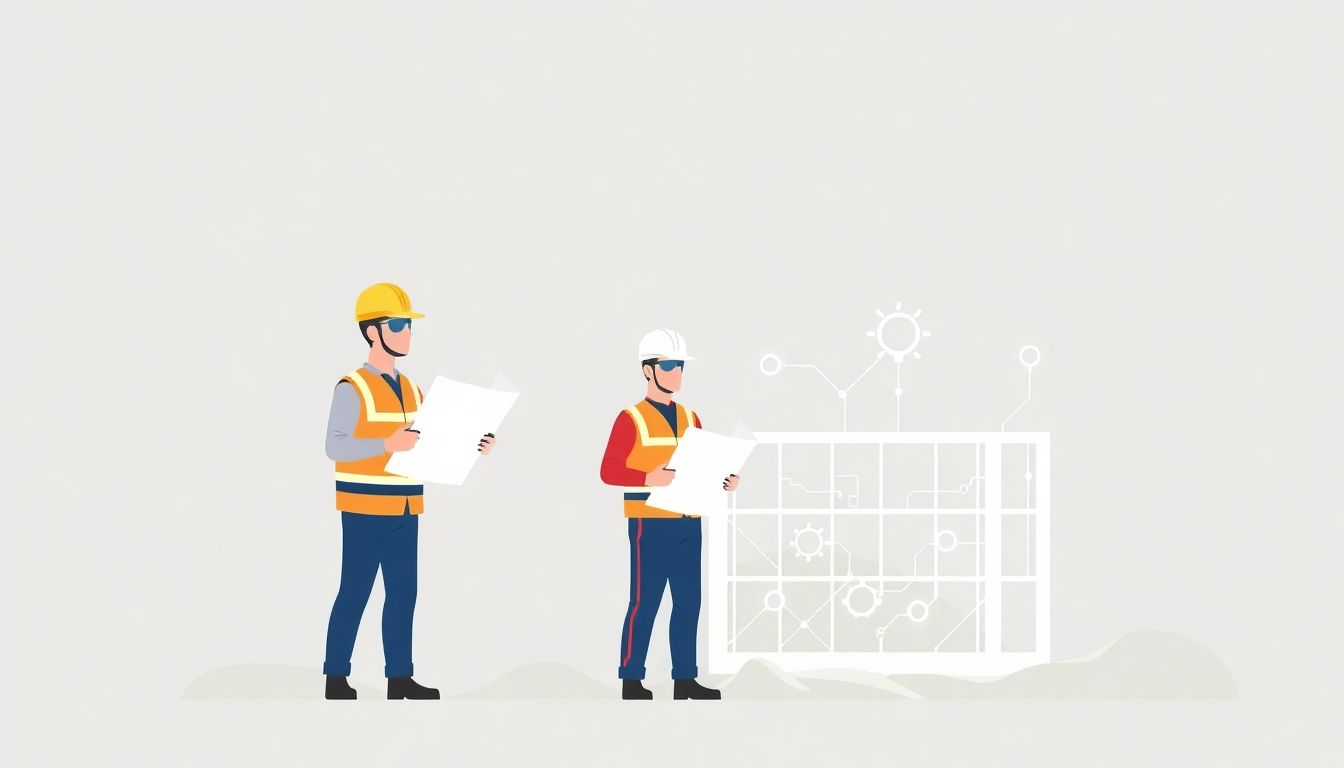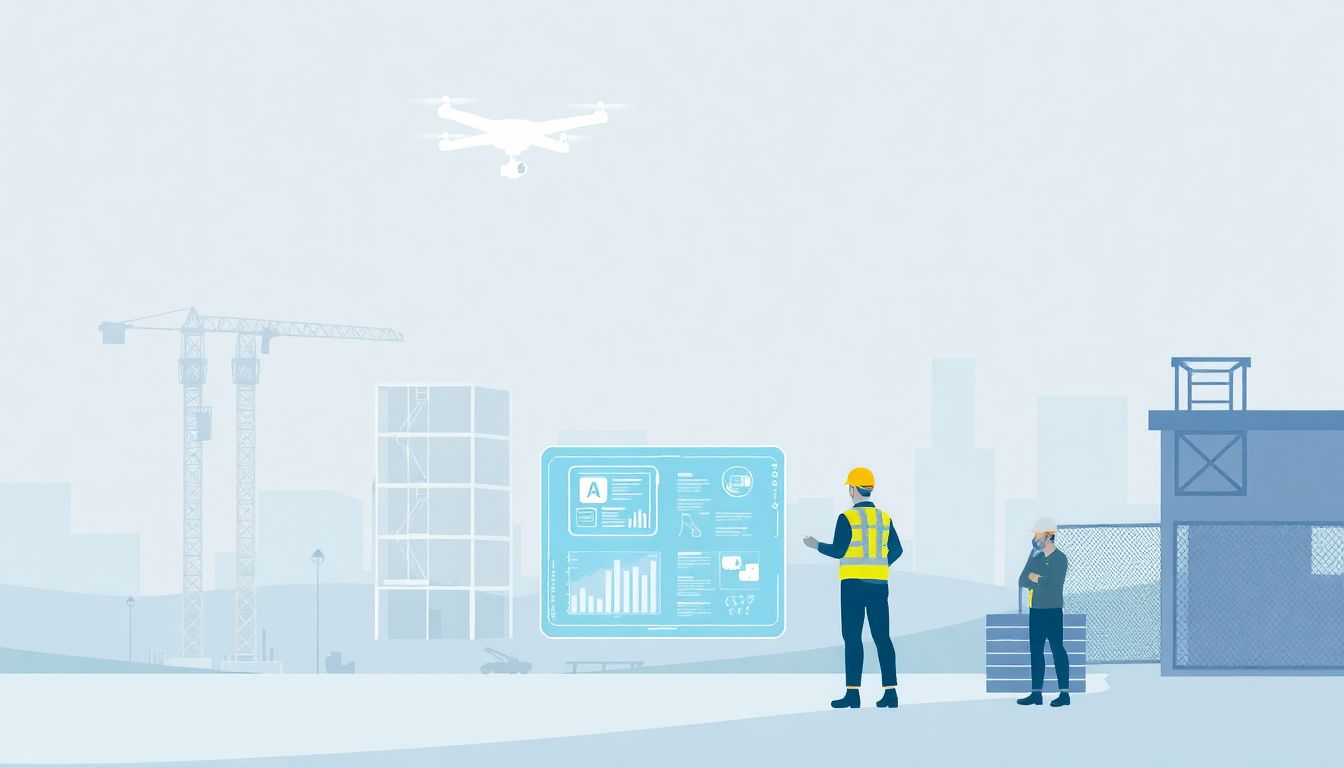Many folks in construction feel overwhelmed by the challenges of managing projects, safety, and deadlines. They often wonder if there’s an easier way to get things done without sacrificing quality.
If you keep reading, you’ll see how AI is proving to be a real helper, fixing problems and making work smoother. From smart tools to automation, AI is already changing the game for builders everywhere.
In just a few words, I’ll share how AI can help your projects run better, safer, and faster—so you’re not left behind in the dust of innovation.
Key Takeaways
Key Takeaways
- AI helps construction teams predict delays, improve safety, and reduce rework by using smart tools and real-time site monitoring. It speeds up decision-making and cuts costs.
- Tools like drone tracking, automated photo documentation, and scheduling algorithms keep projects on track, catching issues early and saving time.
- AI enhances site safety with cameras and sensors that detect hazards or rule violations immediately, making workplaces safer and more compliant.
- Cost forecasting and budget management get more accurate with AI analyzing past data, helping avoid overruns and plan better for expenses.
- Communication and teamwork improve as AI platforms flag inconsistencies, automate updates, and enable better collaboration among all parties involved.
- Talent sourcing and workforce planning benefit from AI by identifying skilled candidates faster and predicting staffing needs based on project timelines.
- AI supports sustainability by minimizing waste, monitoring resource use, and simulating energy-efficient designs before construction begins.
- Remote and off-site construction projects gain from AI through virtual site monitoring and drone footage, reducing travel and enabling quick issue resolution.
- Expect AI to continue advancing with predictive tools, autonomous equipment, and smarter collaboration tools, keeping the industry competitive in the future.

AI Now Is Solving Construction Challenges Faster and Smarter
Artificial intelligence has become a game-changer in construction by tackling some of the industry’s toughest problems. From predicting project delays to improving safety, AI tools help teams make smarter decisions faster.
For example, AI models like Support Vector Machines (SVMs) and Artificial Neural Networks (ANNs) are used to predict material quality with accuracy up to 99%, reducing costly rework. At the same time, computer vision powered by AI enables real-time site monitoring, quickly spotting safety hazards and reducing accidents.
The construction market is booming—projected to hit $22.68 billion by 2032 with an annual growth rate of 24.6%—and AI adoption is soaring as firms recognize these benefits. Large companies with revenues over $50M have increased AI use from 8% in 2020 to 39% in 2025, showing a 5x jump. With 82% of firms planning to boost AI budgets next year, it’s clear that AI is here to stay.
Practical AI Tools That Are Making a Difference Today
There are already several AI-powered tools transforming construction work now. For instance, platforms like **Buildots** use drone footage combined with AI to track progress and catch delays early. Similarly, **OpenSpace** offers AI-enhanced photo documentation that automatically organizes images and flags issues.
Other tools automate routine tasks, such as drawing reviews or quality checks, which traditionally took hours. AI-driven scheduling algorithms also optimize project timelines by analyzing past data and predicting potential bottlenecks—saving both time and money. If you’re wondering whether your project could benefit, exploring these tools can lead to immediate improvements in efficiency.
How AI Enhances Site Monitoring and Safety on Construction Sites
Keeping workers safe is a top priority, and AI is helping make sites safer than ever. AI-powered cameras and sensors monitor activity continuously, identifying unsafe behaviors or conditions in real time. This means hazards like falls or equipment mishandling are spotted right away, allowing quick intervention.
For example, safety systems utilizing computer vision can detect if workers aren’t wearing hard hats or if scaffolding is compromised, reducing workplace accidents significantly. This safety tech not only protects workers but also helps firms comply with regulations, potentially lowering insurance costs.
In a busy project, it’s easy for hazards to slip by unnoticed, but AI keeps a watchful eye 24/7, giving peace of mind and a safer environment for everyone involved.

10. Explore How AI Improves Cost Estimation and Budget Management
Accurate cost estimation can make or break a construction project, and AI is stepping in to help firms get it right. By analyzing historical data, AI models can predict costs more precisely, reducing surprises later on.
Tools like **PlanSwift** now incorporate AI to analyze project scopes and suggest realistic budgets based on similar past projects. This means fewer budget overruns and happier stakeholders.
For example, AI can identify potential cost spikes early—think material price fluctuations or labor shortages—and recommend adjustments before they become issues. A practical tip? Use AI-powered estimate software to run multiple what-if scenarios, so you’re prepared for different outcomes.
Next time you’re planning, try feeding your project data into AI tools to generate more reliable estimates, saving you both time and money in the long run.
11. Show How AI Facilitates Better Collaboration and Communication
Keeping everyone on the same page can be a challenge, especially on large projects with many subcontractors. Luckily, AI helps bridge communication gaps and streamline collaboration.
Platforms like **Procore** and **Autodesk Construction Cloud** utilize AI to analyze project updates, flag inconsistencies, and suggest action steps. This way, teams hear about issues early, rather than after delays happen.
Using AI chatbots can also answer routine questions from field workers or supervisors, freeing up project managers to focus on bigger issues. To make this work, establish a central AI-enabled platform where all project data is shared and updated in real time.
Encouraging teams to adopt these tools fosters transparency, reduces miscommunications, and keeps the project moving smoothly.
12. Discuss How AI Supports Talent Acquisition and Workforce Planning
Finding the right people fast is crucial in construction, especially with labor shortages trending upward. AI can analyze industry trends, skills gaps, and candidate data to help you make better hiring decisions.
Some companies use AI-driven platforms like **BrighterIQ** to screen resumes and predict the best fit for specific roles, saving weeks of manual review. AI can also forecast workforce needs based on project schedules and historical data, helping you plan ahead.
For example, if your project is ramping up, AI tools can suggest where to source skilled workers or recommend upskilling existing staff. A tip? Pair AI insights with your local networks to find qualified candidates faster.
Integrating these practices ensures your team is ready to meet project demands without unnecessary delays.
13. Cover How AI Contributes to Sustainability and Eco-Friendly Construction
Sustainability is no longer optional in construction. AI helps firms reduce waste, optimize resource use, and lower environmental impact.
For instance, AI-driven modeling can suggest material combinations that produce less waste or use recycled content more effectively. Sensors paired with AI monitor energy and water use on-site, enabling real-time adjustments to reduce emissions.
Some projects are now using AI to simulate building performance virtually, ensuring designs are energy-efficient before construction begins. A practical step? Use AI tools to audit your project’s environmental impact and find ways to cut back waste and energy use.
This approach not only benefits the planet but can also lower operational costs in the long run.
14. Explain How AI Facilitates Remote and Off-Site Construction
Remote construction projects, like in off-grid locations or for modular builds, demand new levels of oversight. AI makes managing these projects easier by providing real-time insights regardless of location.
Deploying AI-powered drones and cameras allows project managers to monitor progress and safety remotely. AI analysis of drone footage can detect issues like misaligned modules or safety hazards without a site visit.
For example, a modular home manufacturer can review assembly progress on different sites through AI-processed video feeds, catching problems early. To make this work, set up reliable internet connections on site and use AI tools that integrate seamlessly with your existing workflow.
This reduces travel, accelerates issue resolution, and keeps your project on schedule, even from afar.
15. Discuss the Future Trends of AI in Construction for 2025 and Beyond
Looking ahead, AI in construction isn’t slowing down—it’s expected to become even smarter and more integrated. Features like **predictive analytics** will forecast potential delays before they happen, and **autonomous machinery** might take over more site tasks.
AI is also likely to improve collaborative design—think of real-time co-creation of plans with AI suggesting improvements during meetings. As data collection expands, expect AI to facilitate more sustainable practices, optimize energy use, and push toward greener buildings.
To stay ahead, start experimenting with pilot projects that incorporate AI, and keep an eye on emerging tools. The firms that adapt now will find themselves more competitive and better prepared for 2025 and beyond.
FAQs
AI analyzes project data to identify issues early, predicts delays, and suggests solutions, leading to smoother workflows and reduced costs on construction sites.
Tools like AI-powered scheduling software, safety monitoring solutions, and predictive analytics help enhance efficiency, safety, and decision-making on construction sites today.
AI uses data from cameras and sensors to detect hazards, monitor worker behavior, and alert teams in real-time, reducing accidents and ensuring safer work environments.
Adopting AI helps firms stay competitive by improving efficiency, reducing costs, and enabling smarter decision-making in an increasingly digital construction landscape.